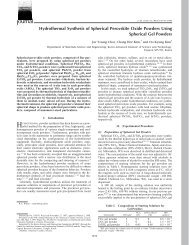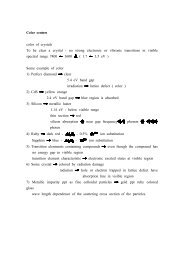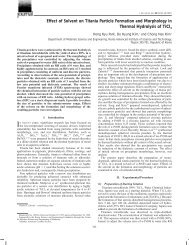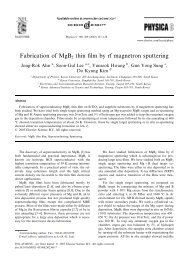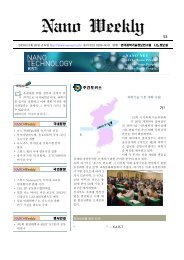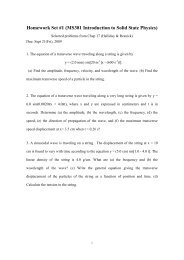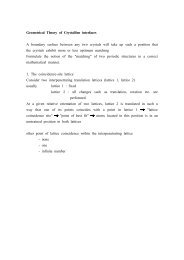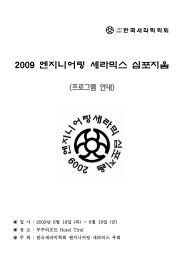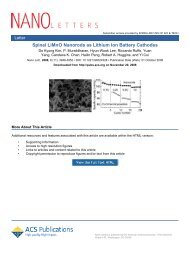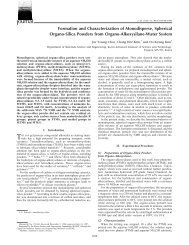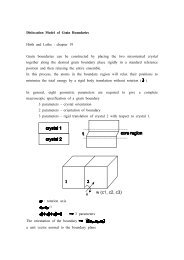Synthesis of Li TiO ceramic breeder powders by the combustion ...
Synthesis of Li TiO ceramic breeder powders by the combustion ...
Synthesis of Li TiO ceramic breeder powders by the combustion ...
You also want an ePaper? Increase the reach of your titles
YUMPU automatically turns print PDFs into web optimized ePapers that Google loves.
208<br />
with excess citric acid in <strong>the</strong> case <strong>of</strong> pure citric acid as a<br />
fuel. The reactivity <strong>of</strong> pure citric acid was lower than<br />
mixed fuel with excess citric acid, i.e. to syn<strong>the</strong>size<br />
<strong>Li</strong>2<strong>TiO</strong>3 powder <strong>by</strong> <strong>combustion</strong> reaction, a fuel must<br />
possess both <strong>the</strong> carboxylic acid group and amine group.<br />
The microstructures <strong>of</strong> <strong>the</strong> syn<strong>the</strong>sized <strong>powders</strong> using<br />
various fuels were observed. A typical micrograph <strong>of</strong> <strong>the</strong><br />
syn<strong>the</strong>sized <strong>powders</strong> is shown in Fig. 3. The <strong>powders</strong><br />
prepared from pure urea Ž A in Fig. 3. and a mixed fuel<br />
with excess urea composition Ž B in Fig. 3. had a cluster <strong>of</strong><br />
aggregates, which were <strong>Li</strong>NO , <strong>TiO</strong> Ž anatase. and unre-<br />
C.H. Jung et al.rJournal <strong>of</strong> Nuclear Materials 253 1998 203–212<br />
3 2<br />
acted fuels. In both cases, <strong>the</strong> reaction is very weak. By<br />
contrast, <strong>the</strong> syn<strong>the</strong>sized <strong>Li</strong>2<strong>TiO</strong>3 <strong>powders</strong> using glycine<br />
Ž F in Fig. 3. formed <strong>the</strong> foamy agglomerated particles.<br />
A lot <strong>of</strong> pores were found on <strong>the</strong> surface <strong>of</strong> <strong>the</strong><br />
syn<strong>the</strong>sized <strong>powders</strong>, which seems to result from <strong>the</strong><br />
evolved gas during <strong>the</strong> <strong>combustion</strong> reaction. The SAD<br />
Ž selected area diffraction. pattern and <strong>the</strong> microstructure <strong>of</strong><br />
as-syn<strong>the</strong>sized powder observed <strong>by</strong> TEM are shown in Fig.<br />
4. While <strong>the</strong> morphology <strong>of</strong> secondary particles was a<br />
porous skeleton, <strong>the</strong> primary particles were ultra-fine and<br />
equiaxed crystalline with a particle size <strong>of</strong> about 20 nm.<br />
The SAD pattern shows clear rings, which means that <strong>the</strong><br />
syn<strong>the</strong>sized powder is very fine crystalline.<br />
Considering <strong>the</strong> above results, <strong>the</strong> <strong>Li</strong> <strong>TiO</strong> powder<br />
2 3<br />
could be easily syn<strong>the</strong>sized <strong>by</strong> <strong>the</strong> <strong>combustion</strong> reaction<br />
with glycine or a mixed fuel <strong>of</strong> urea and citric acid which<br />
is consisted <strong>of</strong> both <strong>of</strong> amine group and carboxylic group.<br />
3.2. Phase formation with ratio <strong>of</strong> fuel to nitrate<br />
It is known that one <strong>of</strong> <strong>the</strong> major parameters that<br />
determines <strong>the</strong> phase formation and <strong>the</strong> morphology <strong>of</strong> <strong>the</strong><br />
syn<strong>the</strong>sized powder is <strong>the</strong> ratio <strong>of</strong> fuel to metal nitrate in<br />
<strong>the</strong> <strong>combustion</strong> reaction w9,10 x.<br />
When a precursor solution<br />
has <strong>the</strong> stoichiometric ratio <strong>of</strong> fuels to metal nitrates, <strong>the</strong><br />
reactivity and <strong>the</strong> phase formation are <strong>the</strong> most desirable.<br />
In this study, effects <strong>of</strong> <strong>the</strong> ratio <strong>of</strong> fuels to metal nitrates<br />
on <strong>the</strong> characteristics <strong>of</strong> <strong>the</strong> syn<strong>the</strong>sized powder were<br />
investigated in a precursor solution consisting <strong>of</strong> glycine as<br />
a fuel and a mixed nitrate <strong>of</strong> lithium and titanium.<br />
Fig. 5 shows XRD patterns for <strong>Li</strong> <strong>TiO</strong> produced at<br />
2 3<br />
three different ratios <strong>of</strong> glycine to nitrates. Three different<br />
compositions are fuel-lean which denotes <strong>the</strong> precursor<br />
solution contains glycine with one-half <strong>of</strong> <strong>the</strong> stoichiometric<br />
ratio, fuel-rich which denotes <strong>the</strong> precursor solution<br />
contains two times <strong>of</strong> glycine and fuel-stoichiometric. The<br />
Fig. 4. Bright-field TEM image and SAD pattern <strong>of</strong> as-syn<strong>the</strong>sized <strong>Li</strong> <strong>TiO</strong> <strong>powders</strong>.<br />
2 3



